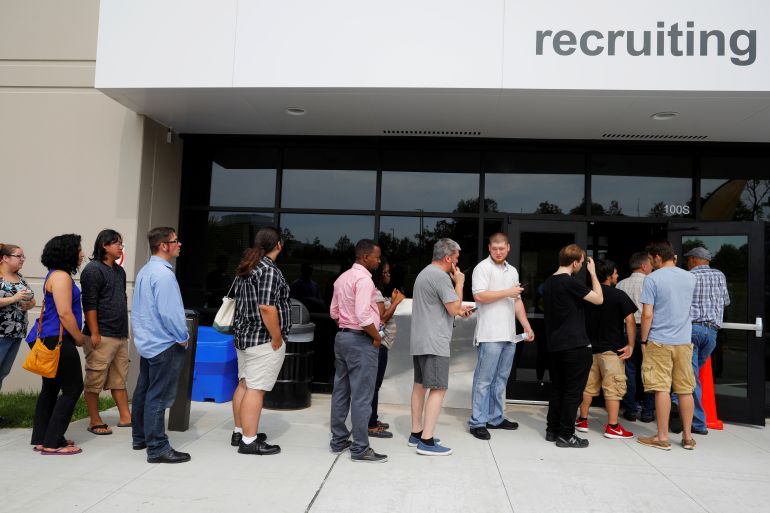US economy adds 661,000 jobs in September as recovery slows
The unemployment rate falls at a time of rising uncertainty over the pace of the US economic recovery and Trump’s re-election bid after he tests positive for COVID-19.

The United States economy added 661,000 jobs in September – fewer than many economists were expecting – while the unemployment rate fell to 7.9 percent, the US Department of Labor reported on Friday.
This is the final monthly snapshot of the US labour market American voters will see before the November 3 presidential election, and the unemployment rate falls at a time of rising uncertainty around the pace of the economic recovery and President Donald Trump’s re-election bid after he and First Lady Melania Trump tested positive for COVID-19.
Keep reading
list of 4 itemsTrump ally Rudy Giuliani files for bankruptcy following defamation case
‘Insurrection’ should bar Donald Trump from US presidency, lawyers argue
Ex-Proud Boys leader Joseph Biggs sentenced to 17 years for US Capitol riot
September marks the fifth straight month of job gains since the economy haemorrhaged more than 22 million of them in March and April as coronavirus lockdowns swept the nation. More than 11.4 million of those positions have been clawed back. But the labour market is still well shy of its pre-pandemic strength.
Back in February, the unemployment rate was hovering near a half-century low at 3.5 percent.
Though job creation is moving in the right direction, it is not moving fast enough for millions of laid-off Americans, many of whom have already faced or are facing permanent job losses.
Tuesday’s debate between US President Donald Trump and Democratic presidential nominee Joe Biden offered nothing in the way of thoughtful discourse on how to get unemployed Americans back to work.
Trump is advocating the same policy mix he used prior to the pandemic to nurse the economy back to health: tax cuts, regulatory rollbacks and a continuation of his administration’s “America First” crackdown on trade deals and trading partners Washington regards as unfair.
Biden’s “Build Back Better” blueprint aims to revive the US economy from the ravages of COVID-19 while redressing long-festering inequalities and the climate crisis. His policy mix includes increasing corporate taxes to fund innovation and buy American products to expand jobs; tax incentives and penalties to encourage US firms to keep and create jobs in the US; a massive $2 trillion investment in clean energy and a federal boost for caregiving.
Multiple gauges of economic activity released this week signal that the recovery is starting to plateau. Layoffs remain widespread, activity at the nation’s factory is downshifting, household incomes fell more than expected in August and consumer spending – the engine of the US economy accounting for some two-thirds of growth – has also slowed sharply.
The entire fall in household incomes is due to the expiration of the federal $600 weekly top to state unemployment benefits at the end of July.
The White House and Congress remain at loggerheads over a new round of virus relief aid and many economists, including US Federal Reserve officials, have warned the economic recovery is at risk of stalling or even derailing without more federal fiscal support from Washington.
Deeper dive into September numbers
A deeper dive into the jobs report shows that the number of unemployed workers stood at 12.6 million in September, one million fewer than the previous month, but almost twice as high as February when 6.8 million Americas were unemployed.
The number of people on temporary layoff fell by 1.5 million last month to 4.6 million – dramatically lower than 18.1 million recorded in April when tens of millions of Americans were thrown out of work during lockdowns.
But the number of permanent job losses rose by 345,000 in September to 3.8 million.
While the nation’s unemployment rate fell to 7.9 percent last month, not all of that recovery was due to positive reasons.
To be counted as “unemployed”, a person needs to be actively looking for work. But in September, about 4.5 million Americans said they were prevented from looking for work because of the pandemic.
Of the 19.4 million Americans who reported that they were unable to work last months because of a pandemic-related closure or lost business, only about 10.3 percent received at least some pay from their employer.
Recovery and inequalities
Prior to the pandemic, the nation’s jobs market was on fire and the racial unemployment gap had narrowed to its lowest on record.
But the ravages of COVID-19 are now exacerbating pre-existing inequalities.
Though September marked the first time in five months that the racial employment gap narrowed, there is a still a considerable gap.
The unemployment rate for whites last month was 7 percent, compared with 12.1 percent for African Americans and 10.3 percent for Latinos.
The jobless rate for men above 20 years stood at 6.5 percent in September compared with 6.9 percent for women.